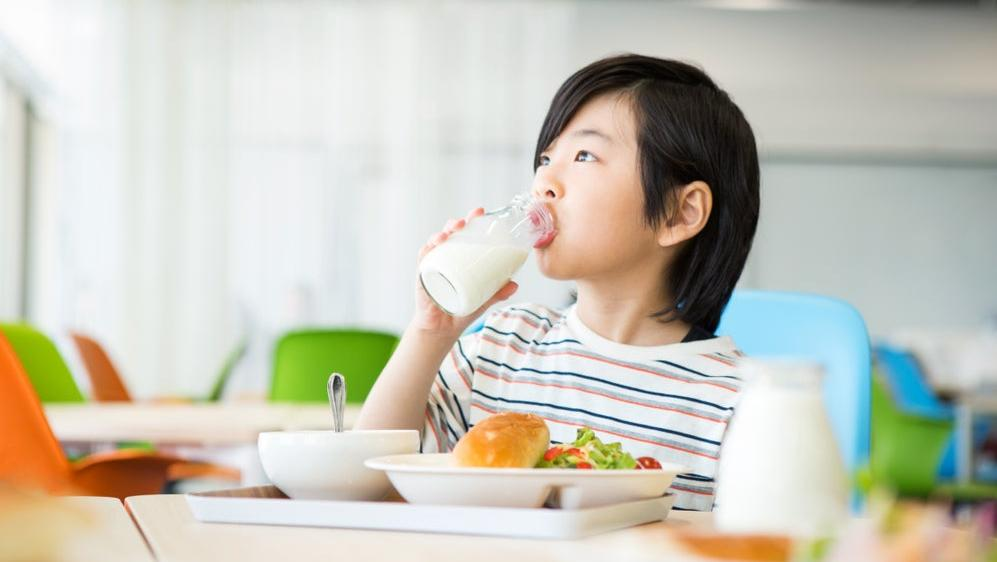Why School Lunches Always Come With Milk
Milk has long been a part of American children's lunch hour. When did that become a thing?
When I think about school lunch, I think first and foremost about milk. It's easy to remember those little cartons and the way the container affected the taste, as milk mingled with the frayed cardboard of the tiny triangular spout.
In the early '90s, my school bafflingly switched to serving milk in bags. The bags were short-lived in my neck of the woods, but it's apparently still happening some places, as this Reddit post shows.
Still, by bag or by carton, the back-to-school season has me thinking back fondly on those little milk servings on the lunch trays. But why exactly is milk such a central part of school lunch in the first place?
Milk is a tool in the fight against malnourishment
American soldiers are partially responsible for the ubiquity of milk in school lunches today. During World War II, it was found that a lot of soldiers had grown up malnourished, due in part to the Great Depression. In 1946, President Harry S. Truman signed into law the National School Lunch Act and in turn created the National School Lunch Program, which established pathways for free and reduced-price meals to be provided in schools.
"President Harry Truman signed the 1946 law, noting the study that showed the biggest reason recruits had been rejected during World War II was for diet-related health reasons, including malnutrition," explains a paper from the United Dairy Industry of Michigan. "Within a year, lunches were served to about 7 million children each day."
Then, in 1954, the government upped its focus on milk by establishing the Special Milk Program, a pathway for child care programs, summer camps, and adult care programs to be reimbursed for milk they provide during the day. This program is for schools and other organizations that aren't otherwise participating in federal school lunch programming. Such programs can also participate in the Child and Adult Care Food Program (CACFP), which provides reimbursement for nutritious snacks, including milk, provided to participants.
How milk in schools has changed
Starting in the mid-2000s, concerns about an increase in obesity among Americans, and in particular among children, inspired revisions to the guidelines about what type of milk is served in schools; the focus shifted from whole milk to skim or low-fat milk. By 2010, there was also a push to move away from flavored milks, which are higher in sugar.
"The Healthy, Hunger-Free Kids Act of 2010 put an even stronger emphasis on nutrition standards for school lunches, breakfasts and snacks," explains the United Dairy Industry of Michigan. "The milk served to the nation's students has changed as well. Schools requested and received milk with lower fat levels, while milk companies reformulated their flavored milk offerings to significantly reduce added-sugar content."
McDonald's has adjusted its kid-friendly meals in kind, which makes sense when you consider that school lunch and McDonald's aim to serve roughly the same target demographic. In 2018, McDonald's dropped chocolate milk and cheeseburgers from its Happy Meal menu in the interest of bringing overall calorie counts down. In 2020, chocolate milk made a comeback, but with 25% less sugar than its predecessor.
Milk delivery methods are evolving, too
As with the aforementioned milk bags of my elementary school experience, the way schools serve milk continues to evolve.
When the milk bags were introduced to my school in the '90s, we had an assembly where a rep from the milk bag company explained how to put a straw into the pouch and what the reasoning behind the shift was. As it was explained at the time, the milk bags, which were just tiny balled-up pieces of plastic once you sucked the milk out of them, would result in less bulk in the garbage bags our school sent to the landfill each day. Of course, that feels like incredibly mid-'90s logic, where "reducing waste" was only about bulk and not longevity; the plastic milk bags I threw away in 1993 might still be sitting in my hometown landfill.
There are arguments to be made for milk bags being more environmentally friendly than big plastic jugs, but as to whether they're more environmentally friendly than tiny cardboard cartons, I'd guess the answer is "no." And, as Eater points out, big jugs may be easier to recycle than the plastic bags, anyway.
Some schools have, however, shifted to milk dispensing machines instead of the cartons, though that requires a school to have a place for the dispenser, cups, and someone to manage the machine.
"If a school prioritizes minimizing labor and/or cost of labor, then individual milk cartons may make the most sense," reads a Vermont paper debating the subject. "If a school prioritizes waste reduction, then bulk milk may be the best option for them."
Whatever form it takes next, it's safe to say milk's not leaving the school cafeteria anytime soon.
